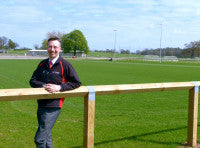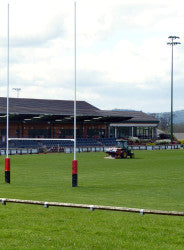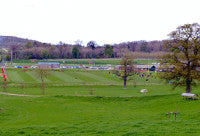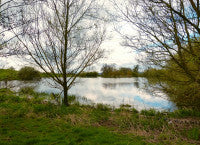Hartpury College; top class surfaces - top class results

It was a cold, dreary morning in October 1949 when a group of apprehensive young men gathered in the entrance hall of an imposing mansion house located near the village of Hartpury, around four miles north-west of Gloucester.
Their backgrounds were as varied as the clothes they wore. Sons of farmers, bankers, bakers and lawyers, a crop of ex-servicemen, a few looking to escape from dreary offices and one or two straight out of school.
Yet, all had one thing in common; they were the very first students to enrol at the Gloucestershire County Farm Institute, set up by the County's Education Committee to provide full-time training in agriculture for those who would be helping meet the nation's urgent need for home-grown food during those austere post-war years.
Over the next twenty-eight years, the college's first principal, John David Griffiths - known to all as "JD" - guided the establishment with dedication and care through many changes.
S

Before his retirement in the late 1970s, JD also oversaw major building works, the acquisition of additional land and the introduction of new courses leading to a National Certificate or Diploma in Agriculture.
Whilst most of the developments at Hartpury College during its first forty years were directed towards agricultural education and training, the past twenty-five have witnessed a dramatic shift in direction, forced on the college by changes within agriculture and the rural economy, along with huge advances in farm mechanisation.
By the late 1980s, student intake had fallen to a point where the existing level of Government support funding could not be justified. With fewer than seventy full-time agricultural students, Hartpury had to turn itself around fast or face closure or a merger with another college.
Appointed in 1990, new principal, Malcolm Wharton, took up the challenge, determined to restore success and a new and positive direction to Hartpury.
The actions he instigated began soon after his arrival. To augment the existing agricultural and horticultural training, he introduced a series of equine, veterinary science and animal care courses, later adding training and further education in sports turf management, countryside and conservation as well as outdoor recreation and leisure.
Although the latter areas were important in helping attract new students to Hartpury's doors, the initial major expansion came within the equine and animal health sectors, helping boost student numbers by more than 1,000 within ten years.

Since then, numbers have more than doubled, fuelled by Hartpury's decision to invest more than £50 million to help make the college one of the leading and most successful sports education, development and training institutions in the UK.
The ability to provide first-class teaching facilities and training standards from academy to elite sports level has been facilitated by Hartpury's superb location, set within a 360 hectare rural estate, the majority of which is still farmed commercially and available for use by one or more of the many diverse courses offered by the college.
These range from A Levels and BTEC Diplomas to short courses and university degrees and include studies in land and agriculture, engineering and mechanisation, animal welfare and management, horse care and equine management, outdoor adventure, veterinary nursing and the uniformed public services.
Over recent years, sports education has helped give Hartpury an increasingly higher profile, helped by the growing number of students the college is attracting from the UK and overseas to study subjects including sports business management, sports coaching, physical education, sports conditioning and injury management, sports performance and a wealth of other related subjects. The list grows bigger year by year.
In addition to the six natural turf and two synthetic 3G pitches used by the college's sports studies students for formal education, training and matches, the college has two additional natural turf pitches dedicated for use by Aviva Premiership side, Gloucester Rugby, whose first team training base has been located at Hartpury for close on ten years, helping forge ever-closer links between college and its local rugby club.

Football, too, plays a very important part within the sports' curriculum with Hartpury actively supporting the playing and coaching development programmes of both Cheltenham Town and Gloucester City Football Clubs.
The college maintains close ties also with Forest Green Rovers, Hereford United, Swindon Town, Bristol Rovers and Newport County.
College football teams have won a succession of important national inter-school and college competitions and former students have gone on to secure professional playing contracts with clubs in the UK and abroad, as well as taking up posts within sports-related areas.
The honours boards at Hartpury College show no signs of gathering dust, thanks to the high standards pursued by the teaching, coaching and administrative staff, together with the superb condition and presentation of the college's playing surfaces and grounds. All grounds maintenance operations are carried out by two teams overseen by Head of Horticulture, Mark Harwood-Browne.
Mark took on responsibility for the grounds in 2010 and for sports turf in 2012, when former head groundsman, Stewart Ward, left to join local football club, Forest Green Rovers.
Modestly describing Hartpury's sports pitch maintenance regime as "surprisingly basic", Mark is supported by two skilled professional groundsmen in ensuring that the college's ten sports pitches and surrounding green areas are kept at the highest possible standard.
The three-man 'Sports Turf' team, led by Tony Hawker, is responsible for looking after all football and rugby playing surfaces, both natural turf and synthetic 3G, the latter having a rubber crumb infill.
This team also maintains a golf driving range and short game area with fine-turf putting green, all of which need to be presented at a high level for use by students selected for the college's golf programme and striving for elevation to the elite and elite development squads.

Although the latter team's working area rarely extends onto sports turf, Mark explained that an amenity mower is able to straddle a touchline or trim the grass behind the goals if its height of cut setting is appropriate.
"We don't impose strict demarcation lines," he said. "Depending on workloads, tasks such as grass-cutting can be shared, as can other jobs such as painting, groundworks or fencing."
The year-round budgetary pressures faced by a wholly self-governing, self-financing college such as Hartpury, mean that on-site student accommodation is very rarely found empty.
Capable of housing more than 1,000 students during term times, the hostel blocks are occupied during vacations by those attending language schools, sports training camps and equine competitions, amongst other events.
In similar manner to the staff responsible for managing and filling the college's hostel accommodation, Mark is striving constantly to make maximum use of the sports pitches under his control.
"Just like a high level rugby or football club, end-of-season maintenance of our main pitches needs to be planned very carefully during the few weeks available to us when no competitive sport is taking place. It's no easy task."

For the main rugby pitch - known as Rugby 1 - and the two pitches used by Gloucester Rugby for training, the 'rest' period starts in early May and ends in mid June.
Rugby 1 is regarded by Mark and his groundstaff as being rather unusual, having exceptionally free-draining abilities, despite the high organic content of the soil which became the college's main rugby pitch in 2002.
Prior to that important event, the area was laid out as an equine arena and covered in a hoof-absorbing layer of shredded rubber. The latter was lifted and removed prior to the seeding of the new rugby pitch on fresh soil brought in to provide a suitably firm, level and true playing surface.
Although the origin of the incoming soil is unknown, the pitch continues to perform very well more than ten years later, despite the fact that it has never been drained.
"Rainwater simply percolates steadily away," commented Mark. "There is a possibility that clay pipes were laid at depth back in the 1950s or '60s when cows grazed the land, but that is a long time ago and no trace of drains has been found during my time at the college."
Fraise-mown and re-levelled just once in the past twelve years, Rugby 1's primary regular maintenance treatment involves monthly deep-tine aeration to 300mm depth using the college's 1.8m Wiedenmann GXi8 HD Terra-Spike complemented by verti-cutting or slitting of the upper rootzone.

During the main growing season, all of the rugby and football pitches are cut two or three times a week at a height of 30mm and 25mm respectively. For optimum presentation, a John Deere 2653A ride-on triple cylinder mower is used on Rugby 1 and Football 1.
Mark Harwood-Browne says that he would like to cut all pitches with cylinders, but limitations on time necessitate the use of tractor-powered Major 1.8m roller rotary finishing mowers for maintaining Rugby and Football 2 and 3 as well as Gloucester Rugby's training pitches.
Although Rugby 1 continues to surprise at its ability to shed water and recover from wet weather, Football 1's drainage benefitted from rejuvenation in 2011 with sand slitting carried out at 1m centres by Chesterfield-based contractor, J Pugh-Lewis Ltd, the firm which constructed the pitch originally in 2009.
Whilst the number one football pitch continues to perform well under fairly relentless playing pressure, the steady ingress of Poa annua over the past two years has been causing concern to Mark.
"Apart from being unsightly, Poa's shallow rooting characteristics reduce both surface stability and the turf's ability to recover quickly after matches," he said. "This year, following advice from our consultant Dave Powell, head groundsman at Northampton Saints, we have taken measures designed to reduce the incidence of Poa. This involved cutting the grass very short prior to harrowing and scarifying the surface to drag out the Poa."
These actions were followed by over-seeding with perennial ryegrass and topdressing of the entire pitch with 60 tonnes of Mansfield pure washed silica sand. "We shall keep a close eye on the surface, but early results look promising," commented Mark. "We intend using similar treatments this year on Gloucester Rugby's two training pitches."
One fact which Mark is proud to highlight is that no fungicides have been used on Hartpury's sports surfaces since he took up his post, a consequence, he believes, of the sound drainage profiles and regular aeration carried out on all pitches to ensure that rainwater is able to move freely downwards and away.

Now covering close to 15,000 sq metres and standing around 2.5m deep towards its centre, the large expanse of water acts as a magnet for aquatic and avian wildlife.
In times of heavy rain, excess water from the lake flows along a stream into the nearby River Leadon, which joins the River Severn at Gloucester.
Although the Hartpury College campus is situated well above the flood plain, the consequence of large-scale flooding downstream at Gloucester is felt at Hartpury when the outflow of excess water from the lake slows dramatically, with a subsequent negative effect on pitch drainage.
"Fortunately, it does not happen too often and the flooding down-stream has to be fairly severe for it to cause us problems," explained Mark. "For the vast majority of most years, our drainage system performs very well."
To maintain good grass growth on free-draining pitches, Mark and his staff are able to call on two Briggs hose-reel irrigators whenever there is a need for additional water during prolonged dry or hot weather, or following new seedings.
"In addition to having the resources of a local weather station, the groundstaff are able to judge visually the need for irrigation depending on the appearance and condition of the turf," he said. "Having the ability to apply water when required is very useful and we make good use of the lake as a reservoir, with the pump house located less than 300 metres from the Rugby 1 pitch."

With a programme currently in place for the application of 300kg/ha of Universal 16 (16:16:16) granular fertiliser three times a year - in line with Dave Powell's recommendations - Mark believes that it could be expedient to look at controlled-release fertilisers to counter the college's reduced irrigation water availability from next year.
"We shall weigh up the costs and probably carry out a trial application on part of a pitch this year," he said. "In the meantime, I am pleased to say that our newest pitch, created in autumn 2012 and known as Football 3, has shown excellent recovery from play which started in earnest last autumn. Sport, and the surfaces on which it is played, simply never stand still at Hartpury."

John Deere 4520 Tractor
John Deere 4520 Tractor with front end loader
John Deere 4320 Tractor
John Deere 855D Gator x 3
John Deere 1545 out front mower with Trimax FlailDek FX155 flail mower
John Deere X740 rotary mowers with high-lift collection hoppers x 2
John Deere 2653A ride-on triple cylinder mower
Wiedenmann 1.8m GXi8 HD Terra Spike
Blec 1.8m slitter
Major 1.8m roller rotary finishing mowers
Honda pedestrian mowers x 6
Various powered hand tools including grass trimmers and hedge trimmers
